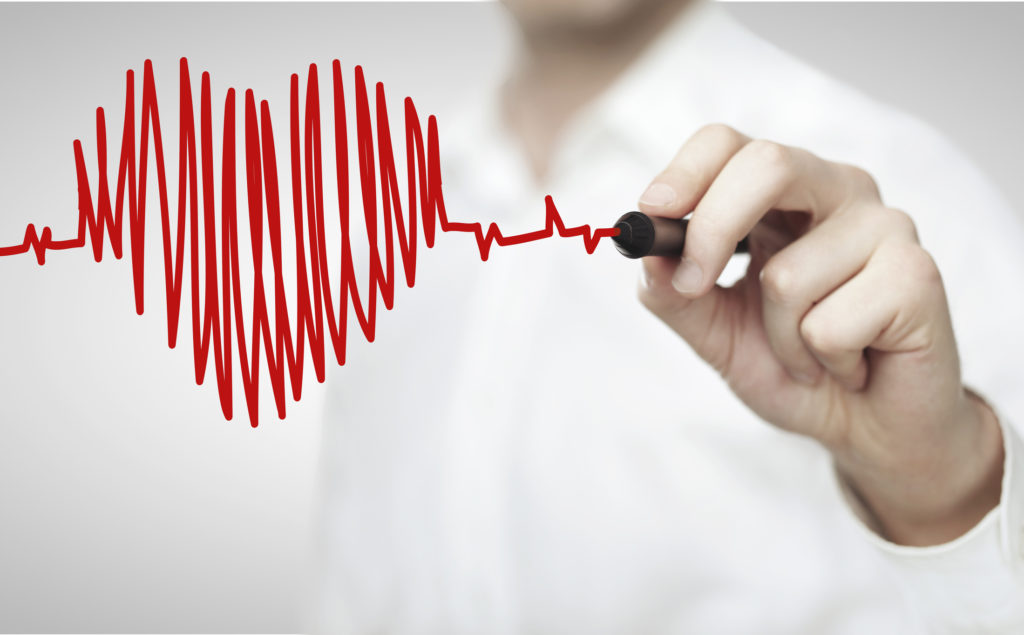Atrial Fibrillation
What is atrial fibrillation?
Atrial fibrillation (A-fib) is an irregular and often rapid heart rate that commonly causes poor blood flow to the body. Atrial fibrillation symptoms include heart palpitations, shortness of breath, tiredness and weakness. However, for many there are no noticeable symptoms.

A-fib can be occasional (symptoms come and go from minutes to hours) or chronic (symptoms will not resolve without treatment).
Detection and diagnosis
The simplest way of detecting atrial fibrillation is by feeling the pulse for an abnormal rhythm. When a clinician suspects A-fib, there are a number of tests that will be carried out in order to establish a diagnosis.
- EKG — An EKG is simply a recording of the electrical activity of the heart done by connecting leads to the body of the patient and monitoring voltage differences on the surface of the body. The test is painless and quick, usually only lasting between one and ten minutes.
- Blood Tests — Atrial fibrillation is most often a condition in its own right. However, it can develop due to disease elsewhere in the body, such as a thyroid gland problem. You may be asked to have a blood test in order to exclude such problems.
- Rhythm Monitoring — With different types of A-fib, your heart is sometimes in a regular heart rhythm (sinus rhythm) and occasionally in the irregular heart rhythm (atrial fibrillation). Therefore, you may be asked to wear a Holter monitor, which is strapped to your chest and will record your heart rhythm continuously for up to seven days.
- Occasionally, when a patient is experiencing many symptoms, but diagnosis is proving difficult to confirm, an “Implantable Cardiac Monitor” may be recommended. This is a small monitor that is inserted beneath the skin of your chest under local anesthetic and then remains in place, monitoring your heart rhythm day and night until removed.
Major complications of atrial fibrillation
Heart failure occurs if the heart can’t pump enough blood to meet the body’s needs. A-fib can lead to heart failure because the ventricles are beating very fast and can’t completely fill with blood. Thus, they may not be able to pump enough blood to the lungs and body.
On average, the risk of stroke is five times greater in A-fib than in normal sinus rhythm (regular heartbeat). During A-fib, the heart’s upper chambers, the atria, don’t pump all of their blood to the ventricles. Some blood pools in the atria. When this happens, a blood clot can form. If the clot breaks off and travels to the brain, it can cause a stroke.
Assessing your risk of stroke
| QUESTIONS | POINTS | YOUR SCORE |
| Are you over 75 years of age? | 1 | |
| Do you have high blood pressure? | 1 | |
| Do you have diabetes? | 1 | |
| Do you have heart failure? | 1 | |
| Have you suffered from a stroke–even a mild stroke? | 2 | |
| TOTAL |
A risk score of two or above may indicate that more clinical assessments are required. Discuss your risk factors and any symptoms with your physician to determine the best treatment for your individual case.
Treating atrial fibrillation
Lifestyle changes can help prevent A-fib and lower your risk of heart disease.
- Follow a heart-healthy diet that’s low in saturated fat, trans fat and cholesterol. A healthy diet includes a variety of whole grains, fruits and vegetables daily.
- Don’t smoke or use tobacco products.
- Be physically active.
- Maintain a healthy weight.
- Keep your cholesterol and triglycerides at healthy levels with dietary changes and medicines (if prescribed).
- Limit or avoid alcohol.
- Control your blood sugar level if you have diabetes.
- Get ongoing medical care and take your medicines as prescribed.
Discuss your questions and symptoms with your health care clinician on a regular basis as you notice changes.
